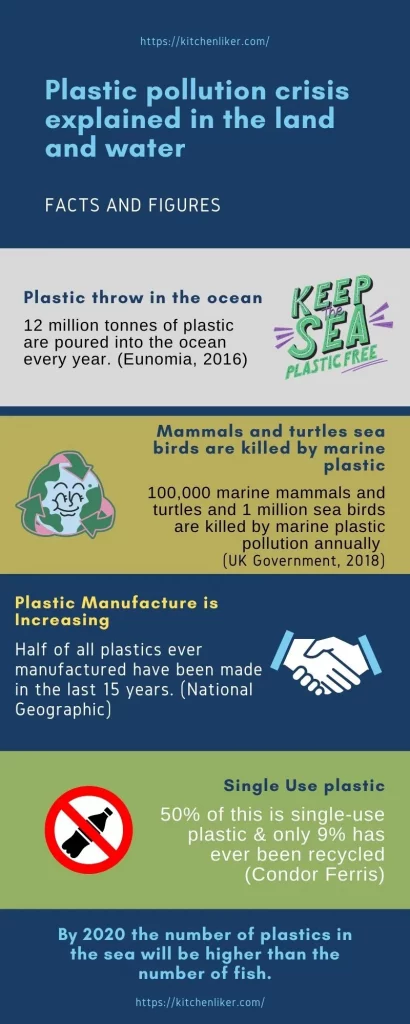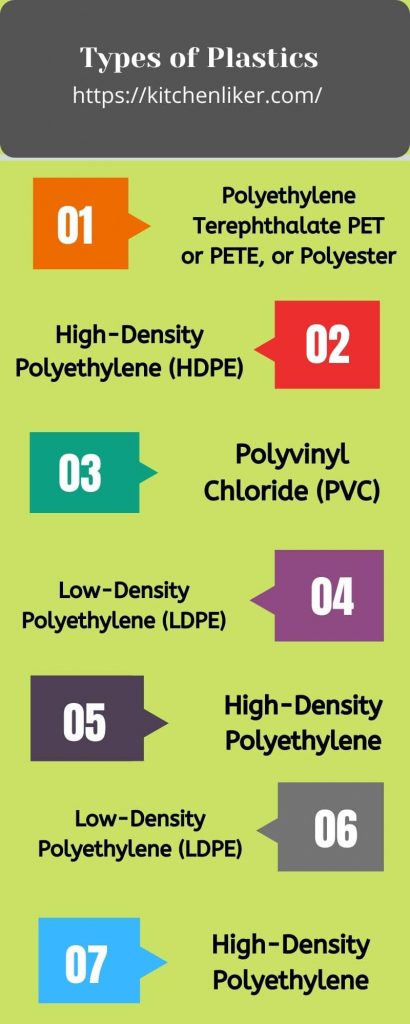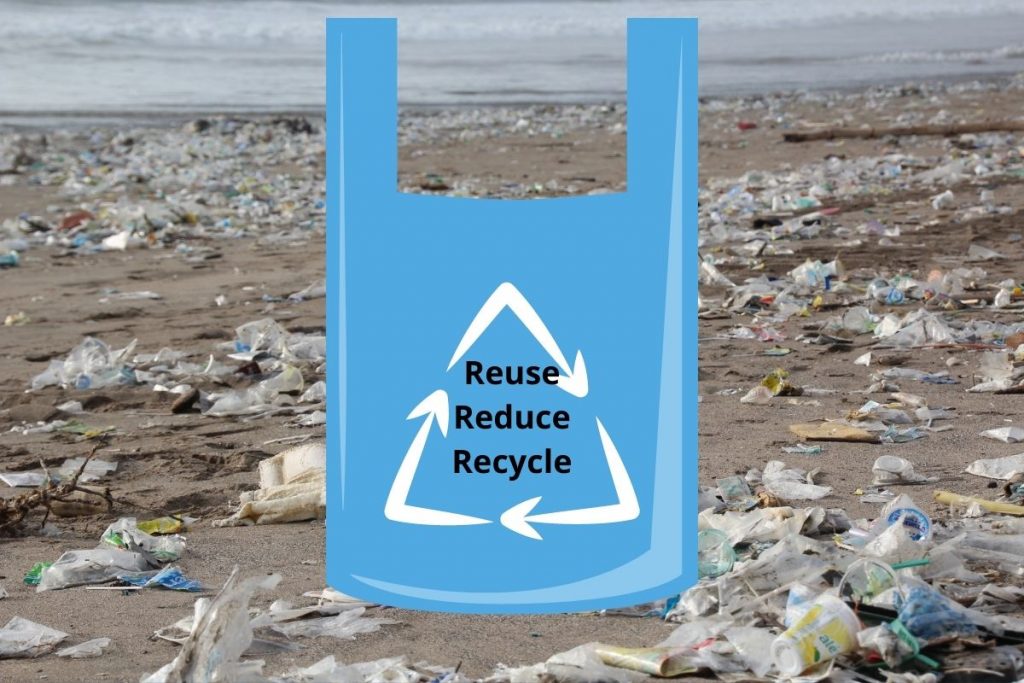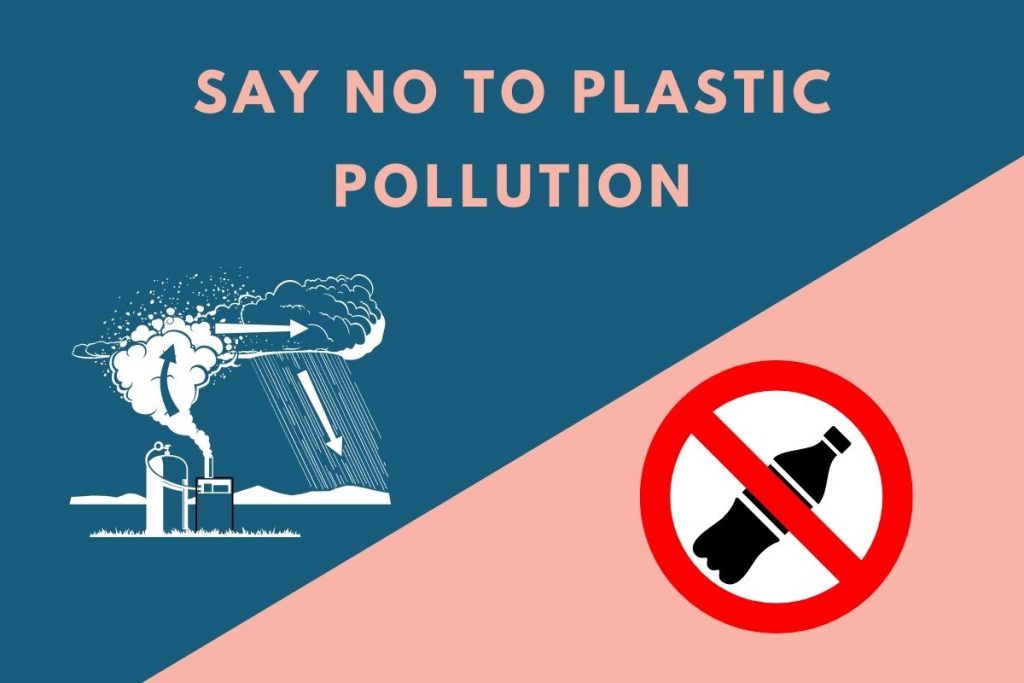The earth’s plastic pollution crisis is raising day by day. The impact of plastics has changed our lives. It is the most popular material that is utilized at home. The pollution caused by plastic is a significant danger to humans and wildlife, as well as the environment. It has influenced medicine as well as decorated vehicles, and even jet planes, and as a result, the surroundings are polluted.
It is not difficult to see that there are some advantages to plastics, due to their weight cost, durability, and affordability. On the contrary, they can negatively affect wildlife, waterways as well as humans. The effects of plastics are a lot of- and have long-term effects on wildlife, humans, and the natural world.

It is believed that in 2050, there will be more plastic than fish in the oceans. The reason for this is because we use so much plastic every day. Plastic does not biodegrade easily; it breaks down into smaller pieces that then get ingested by animals or end up polluting the environment. This causes harm to marine life such as sea turtles, whales, dolphins, seals, birds, and other aquatic species.
Plastics also cause problems with human health. They contain chemicals called phthalates which leach out from plastic products when exposed to heat or sunlight. These chemicals disrupt hormones in both men and women. In addition, these chemicals may interfere with normal development during pregnancy. Phthalate exposure has been linked to reproductive disorders including low birthweight babies, premature births, miscarriages, stillbirths, and infertility.
Plastics do not break down naturally like wood, paper, glass, metal, etc., but instead, break down into microparticles
known as “microbeads”. Microbeads are small enough to enter the bloodstream through your skin and make their way throughout your body. Once inside the body, they collect in organs where they could potentially damage cells.
In conclusion, plastics are an important part of modern society. However, if used properly, they can benefit us all. But if misused, they pose serious threats to our planet. We must take action now before it’s too late!
Harm to wildlife
The plastic pollution crisis is not only a concern of humans but also wildlife. There are many ways that plastics harm wildlife. One example would be how plastic bags kill seabirds. Seals eat them thinking they’re jellyfish. When they swallow the bag, they choke themselves to death. Another example would be how plastic straws hurt penguins. Penguins need to drink seawater to survive. The world’s oceans are being polluted with an estimated 100 million tons of plastic debris every year. This is a problem because there are over 7 billion people on Earth today. If we don’t stop this problem soon, it will cause more problems than just harming wildlife. It could even lead to the extinction of some species.
Straws block their throats causing them to drown. Plastic pollution also harms marine life by killing fish and other sea creatures. The most common way that plastics harm wildlife is when animals mistake them for food. These include birds, seals, turtles, dolphins, whales, and many others. Some animals like sharks mistake these items for jellyfish or squid. They then try to eat them. Unfortunately, they end up choking themselves to death because the item isn’t edible. Other animals mistake the plastic for food and eat it. This can have fatal consequences. For instance, baby sea turtles mistake plastic bags for jellyfish and This leads to starvation.
The ocean is home to many different types of animals. Many of these animals live in the water and breathe through gills. Plastic pollution kills many of these animals by blocking their breathing holes. This causes them to suffocate. In addition, plastic pollution blocks their digestive systems. This prevents them from eating properly. As a result, they starve to death.
Many animals mistake plastic bags for jellyfish and eat them. This leads to starvation. Some animals mistake plastic bottles for jellyfish and eat them.
Harm to Humans
Another problem with plastics is that they don’t decompose very quickly. If you throw away something made of plastic, chances are it won’t disappear until it gets buried under soil or composted. That means that people who live near rivers and streams often find large amounts of trash floating downstream. People living along coastlines face similar issues. Plastics tend to accumulate in coastal areas because currents carry them toward shore. One of the biggest concerns about plastics is what happens after people die. Many times, bodies decompose quickly without being buried. If you look around your house, you’ll notice things like wrappers, bottles, and food containers. All of those items were once alive. Some of them had families who loved them just like you love yours. Now they’re dead. And they won’t ever come back again. That means no one else will care for them.
Other Harmful Effects
Plastics can also harm humans indirectly. For instance, they can contaminate food and drinks. Some foods even come packaged in plastic containers. As mentioned earlier, plastics can also lead to hormone disruption. And finally, plastics can clog drains and sewers leading to flooding. This causes a lot of property damage and makes life difficult for emergency responders.

Types of Plastics
Knowing the various kinds of plastic is essential in understanding the complexity of upcycling, recycling, and the health risks that are associated with plastic. The keyword here can be “complexity.” The subject is an enormous subject, and this article is merely an introduction, intended to provide a brief introduction for people with only a little or no understanding but not a thorough overview at those who already know.
It is the first thing to be aware of the fundamentals for the kinds of plastic that are most commonly encountered, classified according to the recycling code for them. This is a brief guideline:
Type 1 Polyethylene Terephthalate PET or PETE, or Polyester
Stomach plastic is used to make juice bottles, water bottles, soft drinks salad dressing, butter, vegetable oil, mouthwash, cosmetics, and more. These plastics are a lot thinner and smooth. Stomach plastics don’t contain toxic bacteria, phthalates Polypropylene – commonly known as “white” plastic: milk jugs, shampoo bottles, detergent bottles, yogurt cups, cereal packaging, etc. These types of plastics have been found to leach bisphenol A, which has been linked to cancer, heart disease, diabetes, obesity, and other health problems. or harmful fungi however its use is in the production of antimony trioxide. Research suggests that long-time temperatures can be harmful to antimony that is removed from inside the stomach bottles. Therefore, it is crucial to protect these bottles from extreme temperatures. Type 1 stomach plastic is intended for one-time use only.
Type 2- High-Density Polyethylene (HDPE)
The most commonly used plastic used in the world is polyethylene. High-thickness polyethylene is made from petroleum, a kind of plastic that is resistant to. High-density Polyethylene is utilized in opaque milk bottles, shampoo bottles, grocery bags, and juice containers, as well as medicine bottles, etc. Polyethylene with high density is moderately strong irritating, peevish, and is ‘heat-prone. It isn’t contaminated with destructive BPA and phthalates. There isn’t any real health risk associated with this type of plastic. Indeed, some studies have shown that when sunlight is left on for a long period the gets released from the plastic of type 2 into ultraviolet radiation.
Contrary to type 1, plastics of type 2 are thought to be safer for drinking and eating. However, there aren’t many options available for those who want to buy food packaged in HDPE. In fact, because of their durability, they’re often discarded after just one use. That means that if you eat something wrapped in an HDPE container, then throw away the wrapper, chances are that you’ve consumed some plastic along with your meal. If you do decide to reuse them, wash them thoroughly before storing them again. Otherwise, you may end up consuming another piece of plastic while preparing dinner! Type 3 Polyvinyl Chloride PVC
Type 3- Polyvinyl Chloride (PVC)
Blister wrap, toys Cling wrap, detergent bottles loose-leaf binders, blood bags, and medical tubing containers are manufactured using Type 3 plastic, also known as PVCPolyvinyl Chloride. Vinyl or PVC is the 2nd most extensively utilized plastic product worldwide, following polyethylene. The manufacturing and removal process of Polyvinyl Chloride (PVC) has been identified as the source of environmental pollution problems that pose serious and health hazards as well. In addition to being a major contributor to global warming, PVC releases dioxins during incineration. This chemical compound causes birth defects, reproductive disorders, immune system damage, liver toxicity, skin irritation, and even death. Furthermore, it’s not biodegradable and will remain intact forever. If you recycle vinyl products, you’ll need to take extra care to ensure that no chemicals get mixed. You should never put anything containing chlorine bleach directly in the recycling bin. Instead, first, rinse out all the soap residue off the item by hand.
Type 4 – Low-Density Polyethylene (LDPE)
Lower Density Polyethylene (LDPE) Plastics can be transparent and opaque. Additionally, the plastic is malleable and strong however it is fragile. These kinds of plastics have the simplest chemical structure for polymers.
Bags of all kinds, including dry cleaning, grocery bread, newspapers bags, frozen food bags garbage bags, hot and cold beverages cups, and coatings for milk containers and plastic wraps are made using Type 4 plastics. It can also be utilized for cable and wire cover. Unfortunately, Low-Density Polyester (LDPE) is very difficult to recycle. It doesn’t break down easily so it ends up contaminating other recyclables. LDPE is usually found inside packaging such as disposable diapers, trash bags, and fast-food wrappers. The problem is that these types of items don’t decompose quickly enough to make sure that the plastic won’t contaminate other materials. Therefore, people must separate each material individually before putting them back into the recycling bins.
Type 5 – High-Density Polyethylene
This is the second most widely used form of plastic. It comes in clear and translucent forms. This particular type of plastic is extremely durable but brittle. They are typically used for making pipes, buckets, drums, car parts, and storage tanks. They are also used for insulation, roofing shingles, and fiberglass boats. Unfortunately, High-Density Polypropylene is highly flammable and toxic. If you see a fire extinguisher near a pile of burning debris, chances are that it was deployed due to a fire caused by a defective hose made from HDPE. Furthermore, the fumes emitted by burning HDPE contain benzene which is classified as carcinogenic.
Type 6 – Polystyrene (PS)
Polystyrene is used extensively in making egg cartons food containers disposable cups and bowls packaging, as well as bicycle helmets. It’s extremely hazardous to the health of humans. Research has shown that styrene can be considered the nervous system and brain poison; it can be a risk to the liver, genes, and the immune system. Polystyrene has a low recycling rate. Only about 20% of PS gets recycled. That means 80% goes straight into our landfills where they leach harmful substances into groundwater. Styrofoam is one of the worst offenders when it comes to this kind of contamination. When we throw away foam cups, plates, utensils, etc., there are always some leftovers at the bottom of the container. These pieces end up getting crushed and compacted over time until they become hard little pellets. Then, if someone tries to dispose of them with regular household waste, they simply go right through your normal rubbish disposal equipment without any trouble whatsoever.
Type 7 – Other
Type 7 refers to the plastics that are not the kind that is mentioned in the 1-6 category and may also be mixed or layered with other plastics, like bioplastics. Polycarbonate containers are made from BPA as well as bisphenol-A. Because of its toxic nature, certain countries have banned the use of polycarbonate.
When we look at the categories above of plastics, it is clear polyethylene Terephthalate is the most suitable type of plastic used for foods and other water-related items.
Reverse Osmosis water purifier utilizes Polyethylene Terephthalate as its purifier. This is the reason why more safe and less harmful drinking water is guaranteed. The best thing about Ultima Water Purifiers is that it does not require electricity. This makes it ideal for areas that do not get a power supply. You will find many different brands on the market today. However, Reverse Osmosis water purifiers are known to provide better quality than others because of their high-efficiency levels. They come in various sizes depending on how much capacity you need. You should choose an appropriate size based on the number of family members who consume water daily.
Solution of plastic pollution
There are several ways to deal with the problem of the plastic pollution crisis. The first step would be to educate yourself regarding what exactly happens during the production process of these products. Once you know all the facts, then you can make informed decisions concerning whether or not you want to purchase such products.
There are alternatives available out there that don’t involve using plastic. For example, you could buy reusable stainless steel bottles instead of buying single-use ones. Another option is to switch to glass jars and mason jars. Glass doesn’t break easily so it won’t cause harm to people around you while being thrown away.
It is important to note that even though glass isn’t 100 percent recyclable, it still helps reduce the amount of trash going into landfills. If you’re looking for something else, consider purchasing bamboo straws. Straws aren’t just eco-friendly but they are also very convenient since they allow us to drink liquids without having to hold them in our hands. Also, if you live near a beach, you might want to invest in sandals rather than flip-flops. Flip flops tend to clog drains and pollute beaches. Sandals are easy to clean after each wear and prevent debris from entering waterways.

Reduce plastic
You can start by reducing the amount of plastic you use every day. Start by cutting down on bottled drinks. Instead, opt for filtered tap water which contains no chemicals and is free of bacteria. Use reusable bags whenever possible. Avoid disposing of plastic wrappers and cutlery in the garbage bin. Try to avoid eating takeout meals unless necessary. Make sure to recycle everything you can. Reduce the amount of meat you eat. Choose fish over chicken and beef. Eat vegetarian once in a while. Stop consuming fast food. Opt for fresh fruits and vegetables instead. Buy organic produce whenever possible.
Reuse plastic
If you must use disposable plastic, try recycling it. Many places offer curbside pickup services where you can drop off your old plastic waste. Some cities even give residents money back when they bring in their recycled materials. When shopping online, check the website’s return policy before making purchases. Most companies will accept returns within 30 days of delivery. Look for stores that sell secondhand goods. These shops usually carry gently worn clothing, shoes, accessories, books, DVDs, CDs, etc. Check thrift store websites for similar options.
Recycle plastic
Plastics are often considered non-biodegradable. However, many plastics have been engineered to degrade more quickly under certain conditions. You should always follow instructions provided by manufacturers when cleaning up spills made from polyethylene terephthalate containers. PET breaks down slowly in sunlight and warm temperatures. In addition, some types of plastic may biodegrade naturally. This depends on how long the material has remained outdoors and exposed to air. Plastic items that contain additives like stabilizers and antioxidants do not decompose as readily. They remain intact until they reach a high enough temperature to melt. Then they begin to release harmful fumes.
What can you do about the plastic pollution crisis?
The first step towards solving the plastic pollution crisis is awareness. The more we know about plastics, the better equipped we’ll be at making informed decisions. So keep reading and learning about plastics. Also, try to reduce your use of single-use plastics whenever possible. Use reusable shopping bags, bring your mug to coffee shops, and avoid buying bottled water.
Finally, recycle everything you possibly can. It doesn’t matter whether it’s aluminum cans, cardboard boxes, or plastic bottles. Recycling helps prevent waste from going into landfills and reduces greenhouse gas emissions. In addition, recycling saves money by reducing the amount of material needed to produce new products. If everyone did these simple steps, we could make a big difference.
Let’s work together to protect our environment from the harmful effects of plastics.

As the chief content writer, Hassan Al Sarker works as a professional kitchen-based content creator at Kitchen Liker.
In addition to reviewing the content published on Kitchen Liker, he ensures that it is accurate, relevant, and helpful. As a result, all the reviews and information published at Kitchen Liker are neutral and userfriendly.
Hassan Al Sarker has a bachelor’s degree in Hotel and Tourism Management From the Newyork University. Before joining Kitchen Liker, he was a contributor at Kitchen Club, United States.


